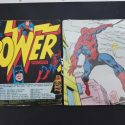[Provisional draft notes shared as a prompt for future research group discussion]
My interest in the sociology of texts, transmedia storytelling and the role of materiality in the reading/collecting/reception/user experience, particularly in the case of comic book cultures, originally found a welcoming conceptual framework within the digital humanities. Recently, my interest has been evolving towards exploring the role of media archaeology within human-computer interaction design.
Media archaeology, as discussed by Jussi Parikka (2011), is a branch of media history that studies contemporary media culture by looking into past (also called “residual”) media technologies and practices. Media archaeology takes a special interest in practices, devices and inventions that may be now otherwise forgotten. It addresses the rapid obsolescence of software and hardware, and poses that their collection, preservation, conservation and study can provide important context for multidisciplinary analysis and innovation.
In particular, I have been recently drafting arguments and potential methodological and domain approaches to critical narrative design and speculative design (sometimes also called “design fiction”, though both terms are not always used to mean the same thing). Needless to say, all these terms have specific meanings and require further clarification and discussion, even for the initiated, let alone those new to them. For an intro into the relationships between the terms “critical design” and “speculative design”, I recommend Anthony Dunne and Fiona Raby’s books, Design Noir: The Secret Life of Electronic Objects (2001) and Speculative Everything: Design, Fiction, and Social Dreaming (2013).

